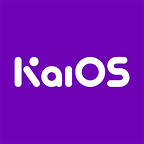Optimizing smartphone apps for smart feature phones
By Morrie Chien, UX Designer at KaiOS
When we redesign smartphone apps, the goal is to transfer the touchable elements to physical keys, while maintaining an exceptional user experience. Read on to discover how we are approaching this process for smart feature phones.
Music
Most smartphone music players consist of an album cover, progress bar, volume control, as well as play and previous/next song buttons.
When we map these functions in smart feature phones, we allocate previous song/play/next song to left/center/right on the directional pad, which is the most intuitive assignment for play control, and is familiar to users of portable music players. In addition, the user can long press the left/right keys to “skip” or adjust the time forward or back by 10 seconds.
Volume control is another important feature. In smart feature phones, users can adjust the volume by using the up/down keys to increase or decrease another intuitive assignment.
Calculator
With the large space at the top of the screen, we can visualize number input, including dividend, divisor, and quotient.
Feature phones have hardware keys for numbers zero to nine, thus the KaiOS team has allocated the basic mathematical symbols addition, subtraction, multiplication, and division to the directional pad, and the equal symbol comes to the center key naturally. The decimal point is assigned to the asterisk key and the plus/minus goes to the pound key. All these symbols make up the bottom part of the screen as a visual cue.
The biggest difference between a smartphone and smart feature phone calculator is the number arrangement. From top to bottom, a smartphone lists the numbers in descending order, which is how traditional calculators are formatted; smart feature phones arrange the keys based on the standard dial phone keypad which lists numbers in ascending order.
Timer
On a smartphone, the duration of the Timer can be adjusted by scrolling a finger up or down across the screen, with some visual effect to create depth, so the user feels as if they are spinning a 3D wheel.
On smart feature phones however, adjusting the time is controlled via the up/down keys, using the left/right keys to switch between units: hour, minute, and second. By relying on physical buttons, the user counts the number of clicks as a very precise method for setting the desired time. This precision serves as an advantage since smartphone options require users to drag gesture a digital wheel, which can be a bit ambiguous and inaccurate, causing users to scroll back-and-forth to land on the exact time.
Stopwatch
On a smartphone, the layout of the Stopwatch is divided into 2 parts. The upper portion of the screen shows the running time and the lower portion of the screen lists lap times.
On a smart feature phone, the screen ratios and sizes are different and require that the Stopwatch adopt a dynamic layout when there is lap time. Without lap time, the running timecode is placed at the center of the screen, but when the user clicks the lap key, the timecode will move up and reserve the space for lap times on the lower portion.
Furthermore, a second running timecode at the top of lap time list is added to inform the user how long the next lap time has run thus far.
We’re happy to know any feedback you have and don’t forget to give me a clap if you enjoyed reading this article! Stay tuned for the next installment of our UX series.
Want to get the latest news of KaiOS? Don’t forget to follow our Twitter, Linkedin, and Facebook.
